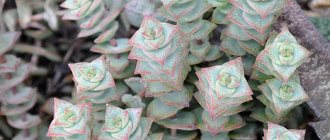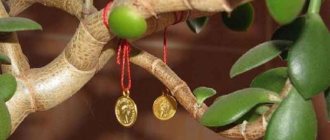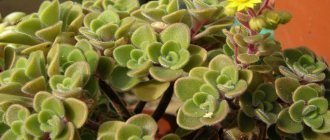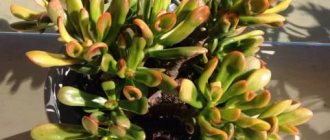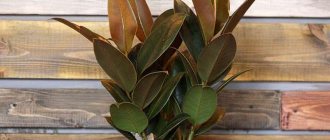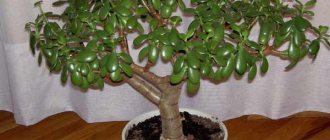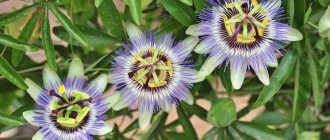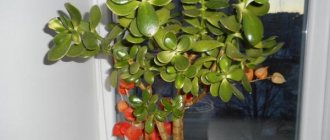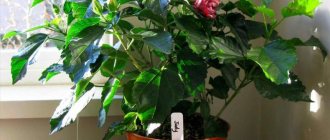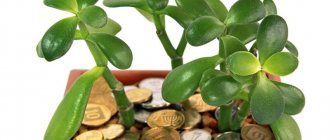The succulent plant Crassula or Crassula belongs to the Crassula family. The flower got its name from its fleshy leaves, since the word “crassus” means “thick”. In nature, representatives of this species are found on the Arabian Peninsula, Madagascar, and South Africa. Many species are grown at home. Flower growers call the Crassula “money tree”, which is associated with many signs and superstitions. In our article you can study the names, types and photos of Crassula, features of caring for the plant and signs of the money tree.
Crassula - types, photos and names
Both in nature and in indoor floriculture, crassulas are found in the form of tree-like shrubs and herbaceous plants. These can be very small succulents or large trees. But all plants have one common feature - fleshy leaves that grow opposite each other on the stem.
At home, Crassula does not have the same large size as in nature, since it grows in a small amount of soil, is limited in space and does not have many other conditions that in nature contribute to intensive plant growth. But even a homemade crassula or money tree from a small shoot or leaf will eventually grow into a tree with a thick trunk.
Crassula leaves, depending on the type, can be entire, simple or ciliated. Under good conditions and proper care, racemes or umbellate-paniculate lateral inflorescences consisting of red, bluish, yellow or white flowers are formed on the Crassula.
Botanical description of Crassula
All representatives belonging to the genus Crassula are very diverse in external characteristics. A significant number of species are indoor perennials with monocarpic shoots of different heights. The foliage is opposite, in some species collected in a kind of basal rosette, simple, entire, often ciliated. The leaves at the base are free or fused.
Flowers are small in size, white, whitish, yellowish, red or bluish in color, collected in terminal or lateral, paniculate-umbellate or racemose inflorescences. There are varieties with single axillary flowers. Caring for the plant and propagating Crassula is very easy.
Types of Crassula - photos, names
There are a large number of types of Crassula, of which we will describe the most popular and in demand for growing at home.
Crassula tree - photo
Crassula of this species is a large plant with a thick, bare trunk and branches on which flat, obovate, round leaves grow. The leaves are three to seven centimeters long and have a light gray color, a bluish tint and red edges. Crassula tree rarely blooms at home. In nature, it produces panicles with white or pale pink flowers.
This type of Crassula loves bright light and does not tolerate shadows at all. With good care, even at home, the tree can grow up to one and a half meters in height. The following varieties of Crassula tree are known:
- curly - the plant got its name because of the wavy large leaves;
- Undulatifolia is a type of Crassula with silver-blue or variegated flat, narrow leaves.
Crassula ovata - photo
This is an ovoid or oval Crassula, which is most often found at home. In nature, the shrub reaches a height of three meters. In an apartment, a tree can grow up to one and a half meters in height. It has a large number of fast-growing shoots with green or silver-gray oval, shiny leaves. Crassula ovata blooms with pink or white flowers, which are collected in umbrella-shaped apical inflorescences.
You will be interested to know: Is it possible to keep ficus in a house, apartment and bedroom?
This species is easy to care for and shade-tolerant. The most famous varieties of the ovata money tree are:
- Crassula Sunset is a plant with beautifully colored leaves, which are distinguished by a bright red border and yellow or white stripes along the edge. This type of Crassula requires good lighting, otherwise the foliage will turn a plain green color.
- Crassula Goluma is an American hybrid variety that is distinguished by its leaves rolled into a tube. The leaves expand funnel-shaped towards the base.
- Crassula Tricolor - from the name of the flower you can understand that its leaves are tricolor. They have red edges and white stripes in the middle on a green background.
- Crassula Hobbit is a hybrid with leaves turned outward, which are fused from the base to the middle.
- Crassula Minor is a compact plant suitable for a mini-garden with leaves no more than one centimeter wide and up to one and a half centimeters long.
Crassula moss - photo
A ground cover plant up to 25 cm high has creeping tetrahedral shoots. The species got its name because it looks like a moss.
Crassula moss is distinguished by small, scale-like leaves that fit tightly to the shoot and are folded in four rows. In intense light, the leaves take on a reddish tint.
Crassula perforata or perforatum - photo
Columnar-shaped fatty plant with diamond-shaped leaves, which seem to be strung on shoots. The leaves have a light green color, a bluish tint and a gristly red border.
Crassula Spring Time - photo
The hybrid form of the Crassula is distinguished by a compact ground part, shoots prone to lodging, bright green, succulent foliage and light lilac flowers.
Crassula rupestris
A herbaceous plant with erect or creeping shoots that can reach 60 cm in length. Its ovoid small leaves, smooth and reddish along the edges, are 1-2 cm wide and 1-2.5 cm long. Umbrella-shaped inflorescences are formed in the upper part of the shoot with yellow flowers.
In addition to those described above, there are also quite a large number of species of domestic crassulas, which differ in the shape, size and color of the leaves, as well as the size and shape of the plant itself.
What does Crassula Marnier look like?
Crassula Marnier is a small, slowly growing succulent 15–20 cm high. Fleshy, plump leaves are round, jade-colored with a coral edge. They are laid tightly on top of each other along the stem and covered with a special film that protects the plant from evaporation. In young plants, the pagons are located vertically, in more mature ones they droop down or spread out on the ground.
On adult specimens, in the middle of winter, umbrella inflorescences with miniature star-shaped flowers, white or pinkish, appear. They decorate the tops of the pagons, but are formed only in the proper temperature conditions - above 22 degrees Celsius and with appropriate lighting.
The natural species has the “Hottentot” variety, bred by breeders, with elongated shoots that look beautiful when hung in a pot. It has a popular name - pearl necklace. The plant itself is not tall - only 15 cm, but very impressive and under good sunlight its leaves become covered with a pink or reddish blush.
A hybrid involving Crassula Marnier and pierced leaf called “Jade Tower” with columnar shoots composed of jade leaves in small white papillae is also popular among domestic flower growers. The flowers are miniature, white and pink, appearing at the end of winter on the tops of the pagons.
Crassula "Jade Tower"
Crassula flower: home care
It is best to place a money tree or crassula on an eastern or southwestern window sill. Some types of Crassula can easily tolerate even direct sunlight. But from a lack of light, a plant can lose its decorative effect. Its leaves turn pale and fall off, the shoots stretch out and the bush becomes ugly.
In the warm season, a tree or herbaceous plant can be placed in the garden or on an open balcony. In winter, you don’t have to worry that a flower pot at home is standing next to working batteries. Crassulas can easily tolerate dry air and heat. If the room is cool, then the air temperature should be at least +10 degrees.
Why do Crassula leaves fall off?
Falling leaves is the most common problem when growing Crassula in indoor floriculture. There may be several reasons for this phenomenon, including improper irrigation measures. Succulents are able to accumulate moisture, which makes them undemanding to watering.
Excessive moisture causes foliage to fall. However, too long interruptions in watering are also unacceptable. Stagnation of moisture often provokes rotting of the root system. Also, massive leaf fall is observed when the temperature in the room is not observed and the plant is damaged by diseases or pests.
How to care for Crassula?
All succulent plants, including Crassula plants, are unpretentious in care. You only need to follow a few simple rules:
- Watering should be regular, but not frequent. In warm rooms, water the soil only when its top layer is thoroughly dry. If the plant is kept in cool conditions in winter, then it should be watered only when the soil dries to a depth of two to three centimeters. Crassulas are plants that are better underwatered than overwatered. Therefore, you should not get carried away with watering the money tree, which can react to constantly damp soil by dropping leaves and rotting the trunk.
- Crassulas only need feeding Fertilizers are used for cacti and succulents. There is no need to feed the money tree in autumn and winter.
- to spray the plant, since all succulents tolerate dry air well. However, in order for the leaves to have a decorative appearance, it is recommended to wash them periodically. You can do this under a warm shower, having first wrapped the pot in cellophane so that water does not fall on the ground.
You will be interested to know: Geranium according to Feng Shui, can you keep it at home, signs and superstitions about the flower
Features of caring for a fat woman
You need to care for Crassula ovata Minor in the same way as other representatives of the Crassula family:
- When purchasing a new plant, you should pay attention to its appearance. The health of the young tree should not raise any doubts.
- Watering should be moderate; a short-term lack of moisture will not affect the health of Crassula Minor in any way, but the earthen clod should not be allowed to become too dry. It is forbidden to flood the tree, as excess moisture will provoke the development of fungus and can cause rotting of the roots and trunk.
- The most successful way to propagate this variety of Crassula is by propagation by cuttings, which, after pruning, easily take root.
- The plant does not need a large pot due to the existing weak root system. The flower has many small and thin roots that slowly fill the space of the pot. The plant is replanted using the transshipment method no more than once every three years. The best time to transplant a flower is spring.
Features of caring for Crassula Minor boil down to controlling the frequency of watering and providing the flower with enough light.
How to transplant a fat plant correctly
Crassula is transplanted into a new pot as needed. To do this, you need to take a container two centimeters larger than the previous one, the bottom of which is filled with drainage and soil for succulents. After this, the plant is carefully removed from the old pot. It must be taken so as not to damage the shoots and break off the leaves. Together with a lump of earth, the bush is placed in a prepared pot, its roots are covered with soil and watered.
Attention! Do not choose large pots for the fat plant! Its roots in such a container will grow deep and its stems will grow upward. As a result, the bush will stretch out and be ugly.
To maintain the compact size of the plant, it does not need to be replanted at all. It will be enough for the fat woman if every spring the top layer of soil is replaced with new nutritious soil.
Similarities with other plants
The genus Crassulaaceae has more than 250 species of plants. All of them are succulents and have similar external characteristics. Some of them may be difficult for an inexperienced gardener to distinguish from each other. The Crassula ovata Minor has the greatest similarity with several representatives of this genus:
- Crassula Sunset , which means “sunset”. This is a compact type of Crassula artificially bred by breeders, which differs from the Minor variety in the color of its leaves. With proper care, Sunset Crassula foliage turns bright yellow-pink colors. Like Minor, Crassula Sunset is suitable for creating miniature gardens.
- Ovata var. Oblique cv. Tricolor has pointed leaves with white stripes and red edges.
- Crassula ovata var. Oblique cv. Solana The pointed leaves of the miniature tree are decorated with yellow stripes.
- Crassula Argentea or silver crassula is distinguished by the fact that the leaf blades are covered with a barely noticeable white coating, which gives the tree a silvery shimmer.
- Crassula ovata is distinguished by the large size of an adult tree.
Check out our experts' articles on other varieties of Crassula, such as: "Mix", "Perforata", "Gollum" (Hobbit), "Tree" and "Buddha Temple" and "Moscow".
Growing indoor indoor flowers is a real art that will not bring the expected results if you do not put your soul and love into it. No matter how hardy the plant is, only with careful attention to it can you achieve positive results and fill the interior with new colors.
Pests and diseases of Crassula
The following pests can cause harm to Crassula at home:
- Spider mites appear on the plant in dry air and if the tree has not been watered for a long time. You can find out about its appearance by the cobwebs on the leaves. The pest is destroyed by treatment with insecticidal preparations.
- Scale appears in the form of brown plaques. You can get rid of it with the help of Actellik.
- Mealybugs look like pieces of cotton wool that can be seen on leaves or shoots. It is removed from the plant using a cotton swab soaked in alcohol.
All pests feed on plant sap, as a result of which the leaves first turn yellow, dry out and fall off, and over time the flower itself dies. Therefore, when they appear, it is necessary to immediately treat them with insecticidal preparations.
The money tree is disease-resistant, but drafts, cold air and excess moisture in the soil can lead to rotting of the roots. As a result, the base of the trunk will begin to rot and the plant will die. It will be possible to save it only if you cut it off and plant more whole shoots.
Planting Crassula Marnier: choosing a container and preparing the soil mixture
To grow a succulent, look for a small vessel that promotes accelerated evaporation of moisture from the substrate - clay or ceramic. In a plastic pot, you will need to place a good drainage layer on the bottom and make additional holes to drain excess water. The plant is quite drought-resistant and will not tolerate overwatering.
Adult Crassulas can grow in one container for several years without replanting, and young plants are moved to a larger bowl as they grow.
The best soil for this species is considered to be a well-drained mixture of sand with high-moor peat and vermiculite or perlite.
Propagation of Crassula by cuttings
The easiest and fastest way to propagate Crassula is by cuttings, which can be used as shoots and leaves. Reproduction is carried out as follows:
- A large leaf or large shoot is cut off with a sharp knife.
- The cut is processed with crushed coal.
- The leaf or shoot is dried at room temperature for two or three days.
- The cuttings are planted in a mixture of leaf soil and sand or in soil for cacti.
- The shoot can first be placed in a solution of water and charcoal, and when it gives roots, transplanted into a small pot.
You may be interested to know: 10 indoor plants that bring happiness and prosperity to the home
It is better to use shallow containers for planting leaves. The shoots are planted in pots with diameters up to 5-7 cm. Caring for them consists of moistening the soil, which is not recommended to be watered too often. The leaves can simply be sprayed with water from a spray bottle occasionally.
Methods for propagating Crassula
Ease of propagation is one of the advantages of this type of decorative perennial. Most often, indoor flowers are propagated by cuttings, but the seed method is also used. You can cut a plant regardless of the time of year , but it is most convenient in spring or summer. The prepared cuttings are dried for a couple of days, after which they are planted in planting containers filled with permeable and light soil substrate. Rooting in water with the addition of activated carbon is also allowed.
Seed propagation involves sowing into seedling containers filled with a mixture based on part sand and a couple parts leaf soil. Crops should be covered with film. Before mass shoots appear, the crops are regularly sprayed with settled water at room temperature and ventilated daily. Mass shoots appear after a couple of weeks, after which they peak.
Money tree in the house: signs and superstitions
It is believed that the fat woman brings prosperity to homes and helps in business. Therefore, this tree can be seen not only in apartments, but also in offices. According to folk superstitions, a money tree will bring prosperity and prosperity to your home under the following conditions:
- The owner of the apartment himself grew the plant from a seed or shoot.
- Crassula will show its best energy abilities in the southeastern part of the apartment.
- Dust that interferes with financial flows must be regularly washed off the leaves of the plant.
- The fat woman needs to talk about her financial problems. If they are resolved, then thank you for your help.
- It is not recommended to place a money tree next to radios, mobile phones, and televisions. They take all the energy from the plant.
- Since money loves to count, when washing a bush you need to count the leaves on the fat one.
- From each amount earned, you should allocate a metal coin, which should lie next to the flower.
- To feed the money tree with additional financial energy, it is recommended to plant it in a red pot or simply tie it with a red ribbon.
- Another sign that will attract financial well-being to the house is tying banknotes between the leaves of the fat plant, which should be renewed periodically.
It is not recommended to give a crassula or even its shoot as a gift. As a last resort, the one to whom the money tree is given must give a coin in return. But you can give Crassula for a wedding. This gift is accompanied by banknotes tied with a red ribbon.
All these signs and superstitions about the money tree have not been scientifically proven. But it is known for sure that the fat man has beneficial properties. The plant releases substances into the air that have antifungal, antiviral and antibacterial effects.
Crassula leaves have medicinal properties and are used for rubbing for arthritis, for the treatment of stomatitis and sore throat, as a lotion for abscesses, cuts, insect bites for the treatment of herpes. However, the leaves of the fat plant contain arsenic, so they should not be taken orally!
Brief description of cultivation
- Bloom . Crassula is grown as an ornamental foliage plant.
- Illumination . It grows well in bright sunshine, as well as in bright but diffused light, as well as in shade. Windows with east, south and southwest orientation are suitable for this.
- Temperature regime . In summer - normal room temperature, and in winter - from 10 to 15 degrees.
- Watering . Immediately after the surface of the soil mixture in the pot dries to a depth of 20 to 30 mm.
- Air humidity . Any one is suitable.
- Fertilizer . During intensive growth, fertilizing is carried out once every 4 weeks, using a fertilizer solution for succulents and cacti. In the autumn-winter period, the plant is not fed.
- Rest period . It is not pronounced. However, it will be better if such a succulent rests in winter.
- Transplant . About once every couple of years. Transplantation is carried out in spring at the beginning of intensive growth of the bush.
- Reproduction . Seed (generative) method and cuttings.
- Harmful insects . Mealy and rootbugs, scale insects, spider mites.
- Diseases . Gray rot, root rot, trunk rot, late blight.
- Properties . This succulent is capable of releasing substances into the air that have antiviral, antifungal and antibacterial effects. In alternative medicine, its juice is used externally in the same cases as aloe juice, and they are also equally effective in terms of effectiveness. But it should be noted that this juice should not be taken orally, since it contains arsenic.
Crassula (crassula). Planting and care.
